University Dental Assisting: HLTDEN007 Radiation Assignment
VerifiedAdded on 2022/10/17
|10
|1735
|6
Homework Assignment
AI Summary
This assignment delves into the principles of radiation biology and protection within a dental practice setting. It begins by outlining the different types of dental radiation, including intraoral and extraoral X-rays, and provides explanations for each. The assignment then addresses radiation protection for dental staff and patients, emphasizing the ALARA (As Low As Reasonably Achievable) principle. It explores various radiation doses, detailing absorbed, equivalent, and effective doses. Furthermore, the assignment covers the stages of dental X-ray film processing, from development to drying, and explains the purpose of components in an intraoral X-ray tube. It also discusses the importance of reporting processing issues, providing details on whom to report to and what information to provide. The assignment concludes by defining film fog, listing its causes, and suggesting corrective actions, along with case studies focusing on patient radiation protection and the use of reference X-rays in dental surgery.

Running head: DENTAL
Dental Assisting
Name of the Student
Name of the University
Author’s Note
Dental Assisting
Name of the Student
Name of the University
Author’s Note
Paraphrase This Document
Need a fresh take? Get an instant paraphrase of this document with our AI Paraphraser
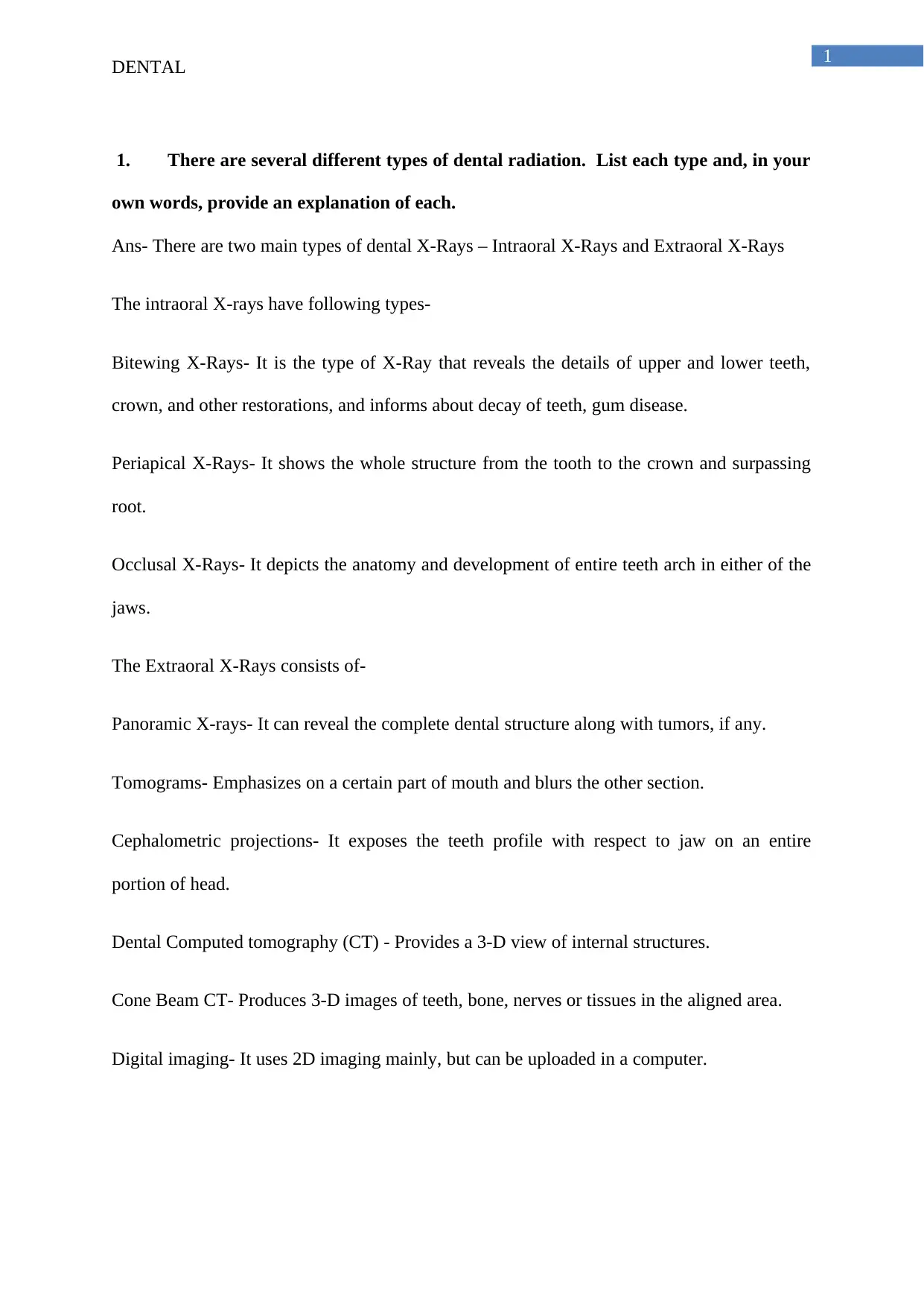
1
DENTAL
1. There are several different types of dental radiation. List each type and, in your
own words, provide an explanation of each.
Ans- There are two main types of dental X-Rays – Intraoral X-Rays and Extraoral X-Rays
The intraoral X-rays have following types-
Bitewing X-Rays- It is the type of X-Ray that reveals the details of upper and lower teeth,
crown, and other restorations, and informs about decay of teeth, gum disease.
Periapical X-Rays- It shows the whole structure from the tooth to the crown and surpassing
root.
Occlusal X-Rays- It depicts the anatomy and development of entire teeth arch in either of the
jaws.
The Extraoral X-Rays consists of-
Panoramic X-rays- It can reveal the complete dental structure along with tumors, if any.
Tomograms- Emphasizes on a certain part of mouth and blurs the other section.
Cephalometric projections- It exposes the teeth profile with respect to jaw on an entire
portion of head.
Dental Computed tomography (CT) - Provides a 3-D view of internal structures.
Cone Beam CT- Produces 3-D images of teeth, bone, nerves or tissues in the aligned area.
Digital imaging- It uses 2D imaging mainly, but can be uploaded in a computer.
DENTAL
1. There are several different types of dental radiation. List each type and, in your
own words, provide an explanation of each.
Ans- There are two main types of dental X-Rays – Intraoral X-Rays and Extraoral X-Rays
The intraoral X-rays have following types-
Bitewing X-Rays- It is the type of X-Ray that reveals the details of upper and lower teeth,
crown, and other restorations, and informs about decay of teeth, gum disease.
Periapical X-Rays- It shows the whole structure from the tooth to the crown and surpassing
root.
Occlusal X-Rays- It depicts the anatomy and development of entire teeth arch in either of the
jaws.
The Extraoral X-Rays consists of-
Panoramic X-rays- It can reveal the complete dental structure along with tumors, if any.
Tomograms- Emphasizes on a certain part of mouth and blurs the other section.
Cephalometric projections- It exposes the teeth profile with respect to jaw on an entire
portion of head.
Dental Computed tomography (CT) - Provides a 3-D view of internal structures.
Cone Beam CT- Produces 3-D images of teeth, bone, nerves or tissues in the aligned area.
Digital imaging- It uses 2D imaging mainly, but can be uploaded in a computer.
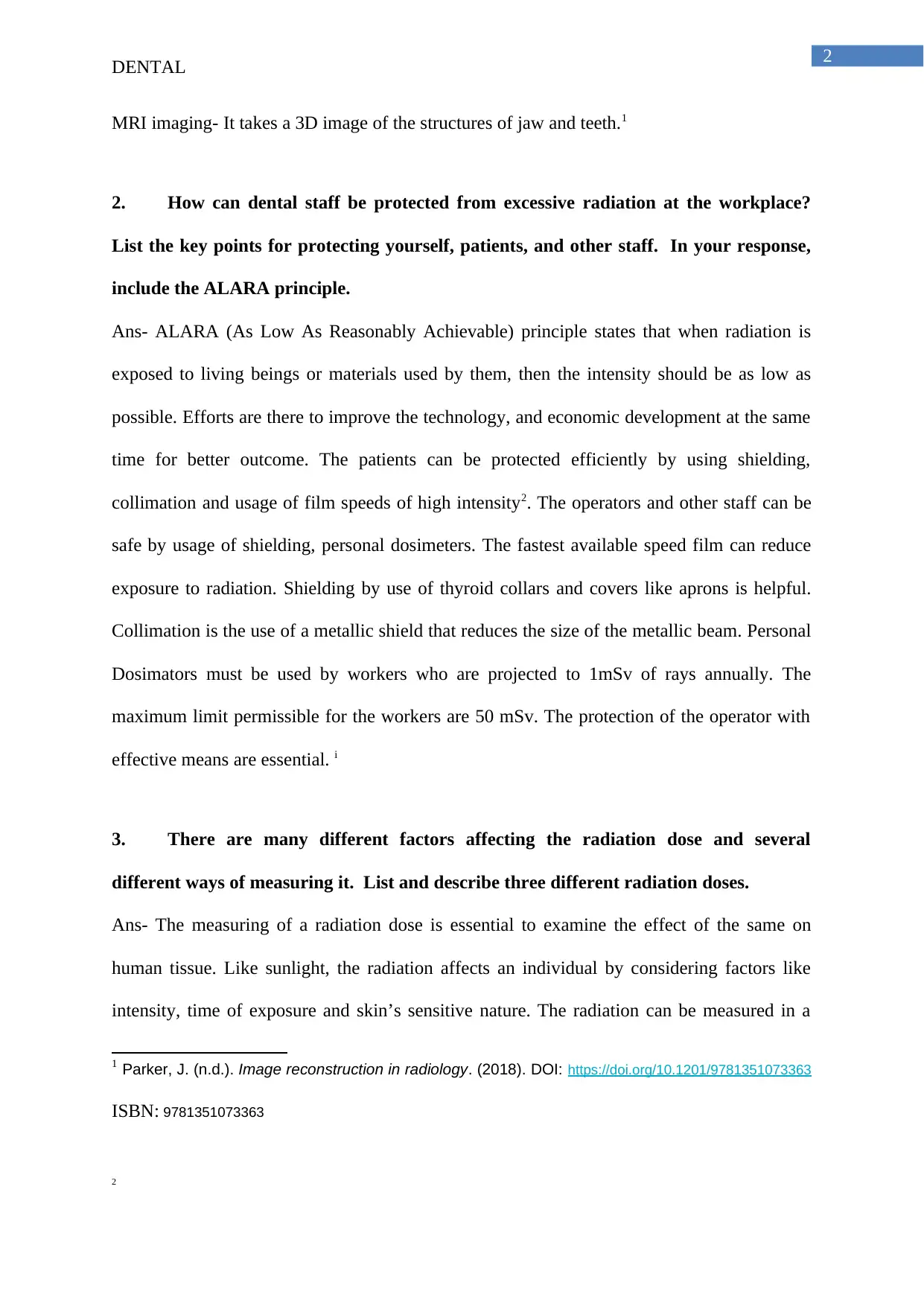
2
DENTAL
MRI imaging- It takes a 3D image of the structures of jaw and teeth.1
2. How can dental staff be protected from excessive radiation at the workplace?
List the key points for protecting yourself, patients, and other staff. In your response,
include the ALARA principle.
Ans- ALARA (As Low As Reasonably Achievable) principle states that when radiation is
exposed to living beings or materials used by them, then the intensity should be as low as
possible. Efforts are there to improve the technology, and economic development at the same
time for better outcome. The patients can be protected efficiently by using shielding,
collimation and usage of film speeds of high intensity2. The operators and other staff can be
safe by usage of shielding, personal dosimeters. The fastest available speed film can reduce
exposure to radiation. Shielding by use of thyroid collars and covers like aprons is helpful.
Collimation is the use of a metallic shield that reduces the size of the metallic beam. Personal
Dosimators must be used by workers who are projected to 1mSv of rays annually. The
maximum limit permissible for the workers are 50 mSv. The protection of the operator with
effective means are essential. i
3. There are many different factors affecting the radiation dose and several
different ways of measuring it. List and describe three different radiation doses.
Ans- The measuring of a radiation dose is essential to examine the effect of the same on
human tissue. Like sunlight, the radiation affects an individual by considering factors like
intensity, time of exposure and skin’s sensitive nature. The radiation can be measured in a
1 Parker, J. (n.d.). Image reconstruction in radiology. (2018). DOI: https://doi.org/10.1201/9781351073363
ISBN: 9781351073363
2
DENTAL
MRI imaging- It takes a 3D image of the structures of jaw and teeth.1
2. How can dental staff be protected from excessive radiation at the workplace?
List the key points for protecting yourself, patients, and other staff. In your response,
include the ALARA principle.
Ans- ALARA (As Low As Reasonably Achievable) principle states that when radiation is
exposed to living beings or materials used by them, then the intensity should be as low as
possible. Efforts are there to improve the technology, and economic development at the same
time for better outcome. The patients can be protected efficiently by using shielding,
collimation and usage of film speeds of high intensity2. The operators and other staff can be
safe by usage of shielding, personal dosimeters. The fastest available speed film can reduce
exposure to radiation. Shielding by use of thyroid collars and covers like aprons is helpful.
Collimation is the use of a metallic shield that reduces the size of the metallic beam. Personal
Dosimators must be used by workers who are projected to 1mSv of rays annually. The
maximum limit permissible for the workers are 50 mSv. The protection of the operator with
effective means are essential. i
3. There are many different factors affecting the radiation dose and several
different ways of measuring it. List and describe three different radiation doses.
Ans- The measuring of a radiation dose is essential to examine the effect of the same on
human tissue. Like sunlight, the radiation affects an individual by considering factors like
intensity, time of exposure and skin’s sensitive nature. The radiation can be measured in a
1 Parker, J. (n.d.). Image reconstruction in radiology. (2018). DOI: https://doi.org/10.1201/9781351073363
ISBN: 9781351073363
2
⊘ This is a preview!⊘
Do you want full access?
Subscribe today to unlock all pages.

Trusted by 1+ million students worldwide
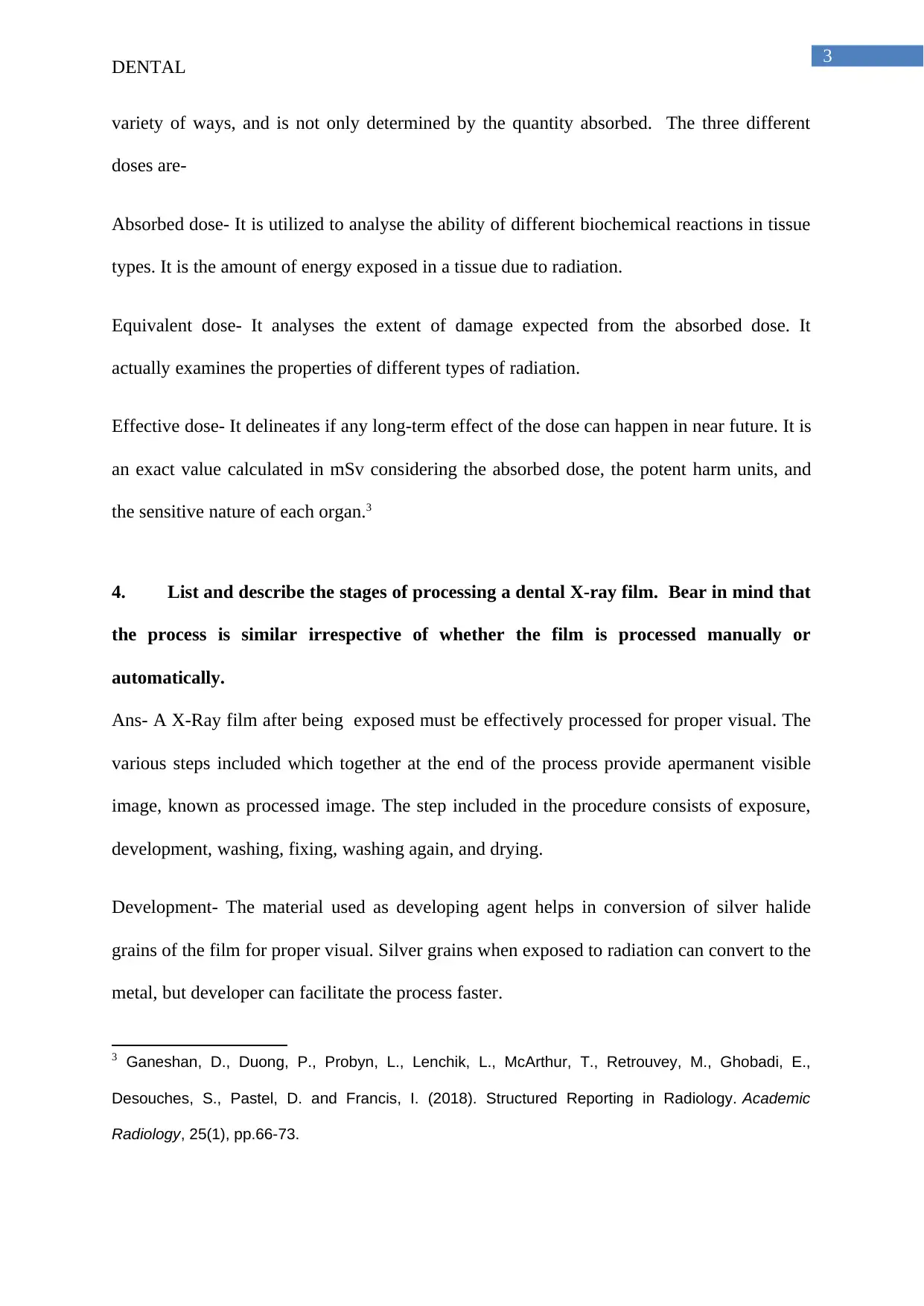
3
DENTAL
variety of ways, and is not only determined by the quantity absorbed. The three different
doses are-
Absorbed dose- It is utilized to analyse the ability of different biochemical reactions in tissue
types. It is the amount of energy exposed in a tissue due to radiation.
Equivalent dose- It analyses the extent of damage expected from the absorbed dose. It
actually examines the properties of different types of radiation.
Effective dose- It delineates if any long-term effect of the dose can happen in near future. It is
an exact value calculated in mSv considering the absorbed dose, the potent harm units, and
the sensitive nature of each organ.3
4. List and describe the stages of processing a dental X-ray film. Bear in mind that
the process is similar irrespective of whether the film is processed manually or
automatically.
Ans- A X-Ray film after being exposed must be effectively processed for proper visual. The
various steps included which together at the end of the process provide apermanent visible
image, known as processed image. The step included in the procedure consists of exposure,
development, washing, fixing, washing again, and drying.
Development- The material used as developing agent helps in conversion of silver halide
grains of the film for proper visual. Silver grains when exposed to radiation can convert to the
metal, but developer can facilitate the process faster.
3 Ganeshan, D., Duong, P., Probyn, L., Lenchik, L., McArthur, T., Retrouvey, M., Ghobadi, E.,
Desouches, S., Pastel, D. and Francis, I. (2018). Structured Reporting in Radiology. Academic
Radiology, 25(1), pp.66-73.
DENTAL
variety of ways, and is not only determined by the quantity absorbed. The three different
doses are-
Absorbed dose- It is utilized to analyse the ability of different biochemical reactions in tissue
types. It is the amount of energy exposed in a tissue due to radiation.
Equivalent dose- It analyses the extent of damage expected from the absorbed dose. It
actually examines the properties of different types of radiation.
Effective dose- It delineates if any long-term effect of the dose can happen in near future. It is
an exact value calculated in mSv considering the absorbed dose, the potent harm units, and
the sensitive nature of each organ.3
4. List and describe the stages of processing a dental X-ray film. Bear in mind that
the process is similar irrespective of whether the film is processed manually or
automatically.
Ans- A X-Ray film after being exposed must be effectively processed for proper visual. The
various steps included which together at the end of the process provide apermanent visible
image, known as processed image. The step included in the procedure consists of exposure,
development, washing, fixing, washing again, and drying.
Development- The material used as developing agent helps in conversion of silver halide
grains of the film for proper visual. Silver grains when exposed to radiation can convert to the
metal, but developer can facilitate the process faster.
3 Ganeshan, D., Duong, P., Probyn, L., Lenchik, L., McArthur, T., Retrouvey, M., Ghobadi, E.,
Desouches, S., Pastel, D. and Francis, I. (2018). Structured Reporting in Radiology. Academic
Radiology, 25(1), pp.66-73.
Paraphrase This Document
Need a fresh take? Get an instant paraphrase of this document with our AI Paraphraser

4
DENTAL
Washing- The stop-bath is used to conclude the above process, where the developer washes
away and the above process stops.
Fixing- The residual silver halide crystals are removed by the fixing process, for avoiding
background in image.
Washing- All the chemicals used to process the film is washed away by this method.
Drying- The film is allowed to dry for proper visual of the image.4
5. Briefly explain the purpose of the following components of an intraoral dental X-ray
tube: Cathode, Anode, Leaded glass housing, Collimator and PIO.
Ans- A X-Ray tube is a simpler device which consists of two principle elements, anode and
cathode.
Anode- The Anode is concerned with converting the electronic energy into the X-radiation.
It also spreads the heat evolved during the process.
Cathode- The cathode helps to focus all the electron beams in the circuit into a single
pathway, aiming the anode.
Leaded glass housing- The X-ray tube housing have diverse function, the principle among
which is providing support to other components. It acts as a barrier being exposed to most of
the beams.
Collimator- In radiology, collimator is used as an absorber, for controlling most of the
harmful beam of X-rays. So, this is an essential component of any X-Ray tube.
4 Itri, J. (2015). Patient-centered Radiology. RadioGraphics, 35(6), pp.1835-1846.
DENTAL
Washing- The stop-bath is used to conclude the above process, where the developer washes
away and the above process stops.
Fixing- The residual silver halide crystals are removed by the fixing process, for avoiding
background in image.
Washing- All the chemicals used to process the film is washed away by this method.
Drying- The film is allowed to dry for proper visual of the image.4
5. Briefly explain the purpose of the following components of an intraoral dental X-ray
tube: Cathode, Anode, Leaded glass housing, Collimator and PIO.
Ans- A X-Ray tube is a simpler device which consists of two principle elements, anode and
cathode.
Anode- The Anode is concerned with converting the electronic energy into the X-radiation.
It also spreads the heat evolved during the process.
Cathode- The cathode helps to focus all the electron beams in the circuit into a single
pathway, aiming the anode.
Leaded glass housing- The X-ray tube housing have diverse function, the principle among
which is providing support to other components. It acts as a barrier being exposed to most of
the beams.
Collimator- In radiology, collimator is used as an absorber, for controlling most of the
harmful beam of X-rays. So, this is an essential component of any X-Ray tube.
4 Itri, J. (2015). Patient-centered Radiology. RadioGraphics, 35(6), pp.1835-1846.
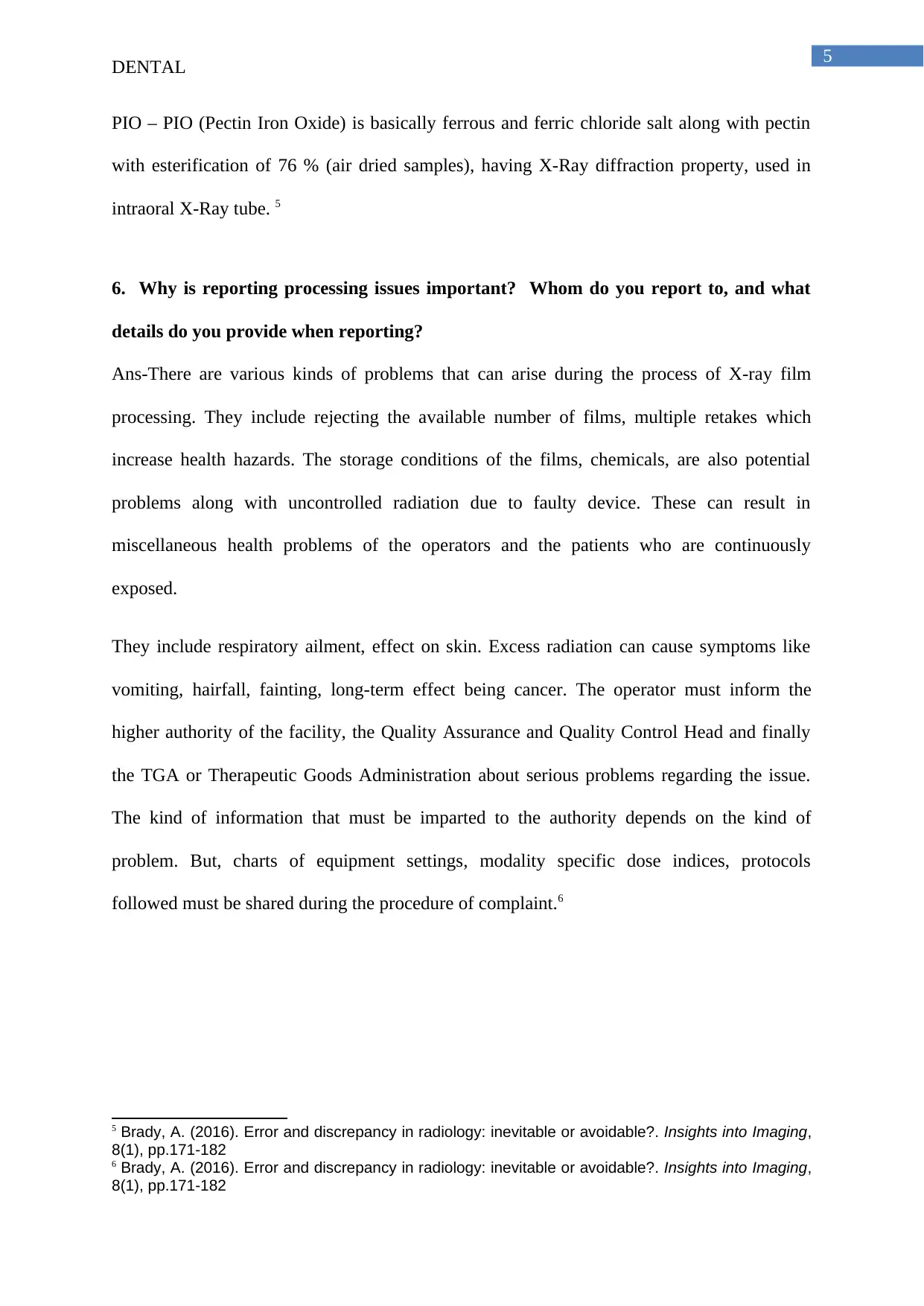
5
DENTAL
PIO – PIO (Pectin Iron Oxide) is basically ferrous and ferric chloride salt along with pectin
with esterification of 76 % (air dried samples), having X-Ray diffraction property, used in
intraoral X-Ray tube. 5
6. Why is reporting processing issues important? Whom do you report to, and what
details do you provide when reporting?
Ans-There are various kinds of problems that can arise during the process of X-ray film
processing. They include rejecting the available number of films, multiple retakes which
increase health hazards. The storage conditions of the films, chemicals, are also potential
problems along with uncontrolled radiation due to faulty device. These can result in
miscellaneous health problems of the operators and the patients who are continuously
exposed.
They include respiratory ailment, effect on skin. Excess radiation can cause symptoms like
vomiting, hairfall, fainting, long-term effect being cancer. The operator must inform the
higher authority of the facility, the Quality Assurance and Quality Control Head and finally
the TGA or Therapeutic Goods Administration about serious problems regarding the issue.
The kind of information that must be imparted to the authority depends on the kind of
problem. But, charts of equipment settings, modality specific dose indices, protocols
followed must be shared during the procedure of complaint.6
5 Brady, A. (2016). Error and discrepancy in radiology: inevitable or avoidable?. Insights into Imaging,
8(1), pp.171-182
6 Brady, A. (2016). Error and discrepancy in radiology: inevitable or avoidable?. Insights into Imaging,
8(1), pp.171-182
DENTAL
PIO – PIO (Pectin Iron Oxide) is basically ferrous and ferric chloride salt along with pectin
with esterification of 76 % (air dried samples), having X-Ray diffraction property, used in
intraoral X-Ray tube. 5
6. Why is reporting processing issues important? Whom do you report to, and what
details do you provide when reporting?
Ans-There are various kinds of problems that can arise during the process of X-ray film
processing. They include rejecting the available number of films, multiple retakes which
increase health hazards. The storage conditions of the films, chemicals, are also potential
problems along with uncontrolled radiation due to faulty device. These can result in
miscellaneous health problems of the operators and the patients who are continuously
exposed.
They include respiratory ailment, effect on skin. Excess radiation can cause symptoms like
vomiting, hairfall, fainting, long-term effect being cancer. The operator must inform the
higher authority of the facility, the Quality Assurance and Quality Control Head and finally
the TGA or Therapeutic Goods Administration about serious problems regarding the issue.
The kind of information that must be imparted to the authority depends on the kind of
problem. But, charts of equipment settings, modality specific dose indices, protocols
followed must be shared during the procedure of complaint.6
5 Brady, A. (2016). Error and discrepancy in radiology: inevitable or avoidable?. Insights into Imaging,
8(1), pp.171-182
6 Brady, A. (2016). Error and discrepancy in radiology: inevitable or avoidable?. Insights into Imaging,
8(1), pp.171-182
⊘ This is a preview!⊘
Do you want full access?
Subscribe today to unlock all pages.

Trusted by 1+ million students worldwide
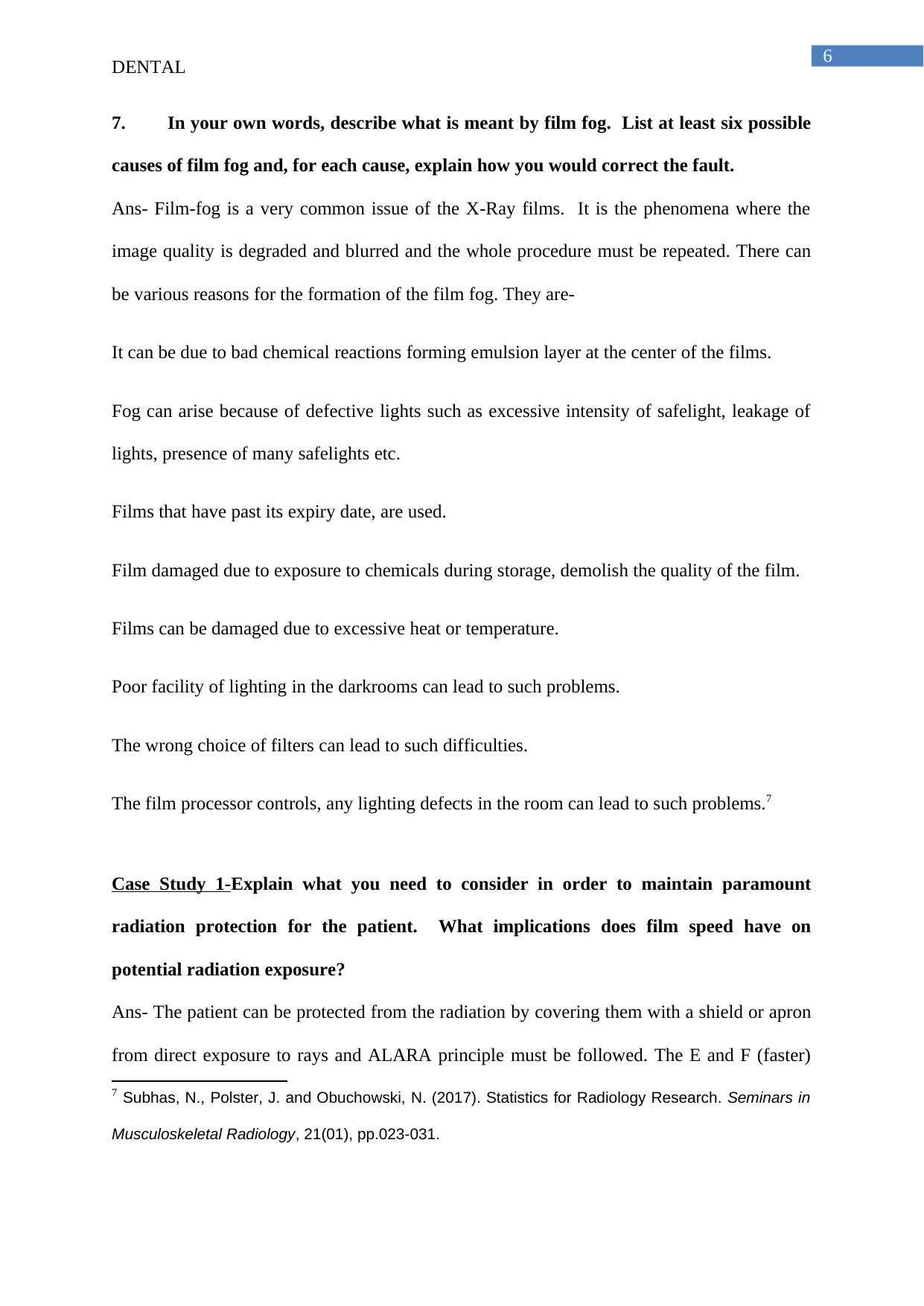
6
DENTAL
7. In your own words, describe what is meant by film fog. List at least six possible
causes of film fog and, for each cause, explain how you would correct the fault.
Ans- Film-fog is a very common issue of the X-Ray films. It is the phenomena where the
image quality is degraded and blurred and the whole procedure must be repeated. There can
be various reasons for the formation of the film fog. They are-
It can be due to bad chemical reactions forming emulsion layer at the center of the films.
Fog can arise because of defective lights such as excessive intensity of safelight, leakage of
lights, presence of many safelights etc.
Films that have past its expiry date, are used.
Film damaged due to exposure to chemicals during storage, demolish the quality of the film.
Films can be damaged due to excessive heat or temperature.
Poor facility of lighting in the darkrooms can lead to such problems.
The wrong choice of filters can lead to such difficulties.
The film processor controls, any lighting defects in the room can lead to such problems.7
Case Study 1-Explain what you need to consider in order to maintain paramount
radiation protection for the patient. What implications does film speed have on
potential radiation exposure?
Ans- The patient can be protected from the radiation by covering them with a shield or apron
from direct exposure to rays and ALARA principle must be followed. The E and F (faster)
7 Subhas, N., Polster, J. and Obuchowski, N. (2017). Statistics for Radiology Research. Seminars in
Musculoskeletal Radiology, 21(01), pp.023-031.
DENTAL
7. In your own words, describe what is meant by film fog. List at least six possible
causes of film fog and, for each cause, explain how you would correct the fault.
Ans- Film-fog is a very common issue of the X-Ray films. It is the phenomena where the
image quality is degraded and blurred and the whole procedure must be repeated. There can
be various reasons for the formation of the film fog. They are-
It can be due to bad chemical reactions forming emulsion layer at the center of the films.
Fog can arise because of defective lights such as excessive intensity of safelight, leakage of
lights, presence of many safelights etc.
Films that have past its expiry date, are used.
Film damaged due to exposure to chemicals during storage, demolish the quality of the film.
Films can be damaged due to excessive heat or temperature.
Poor facility of lighting in the darkrooms can lead to such problems.
The wrong choice of filters can lead to such difficulties.
The film processor controls, any lighting defects in the room can lead to such problems.7
Case Study 1-Explain what you need to consider in order to maintain paramount
radiation protection for the patient. What implications does film speed have on
potential radiation exposure?
Ans- The patient can be protected from the radiation by covering them with a shield or apron
from direct exposure to rays and ALARA principle must be followed. The E and F (faster)
7 Subhas, N., Polster, J. and Obuchowski, N. (2017). Statistics for Radiology Research. Seminars in
Musculoskeletal Radiology, 21(01), pp.023-031.
Paraphrase This Document
Need a fresh take? Get an instant paraphrase of this document with our AI Paraphraser
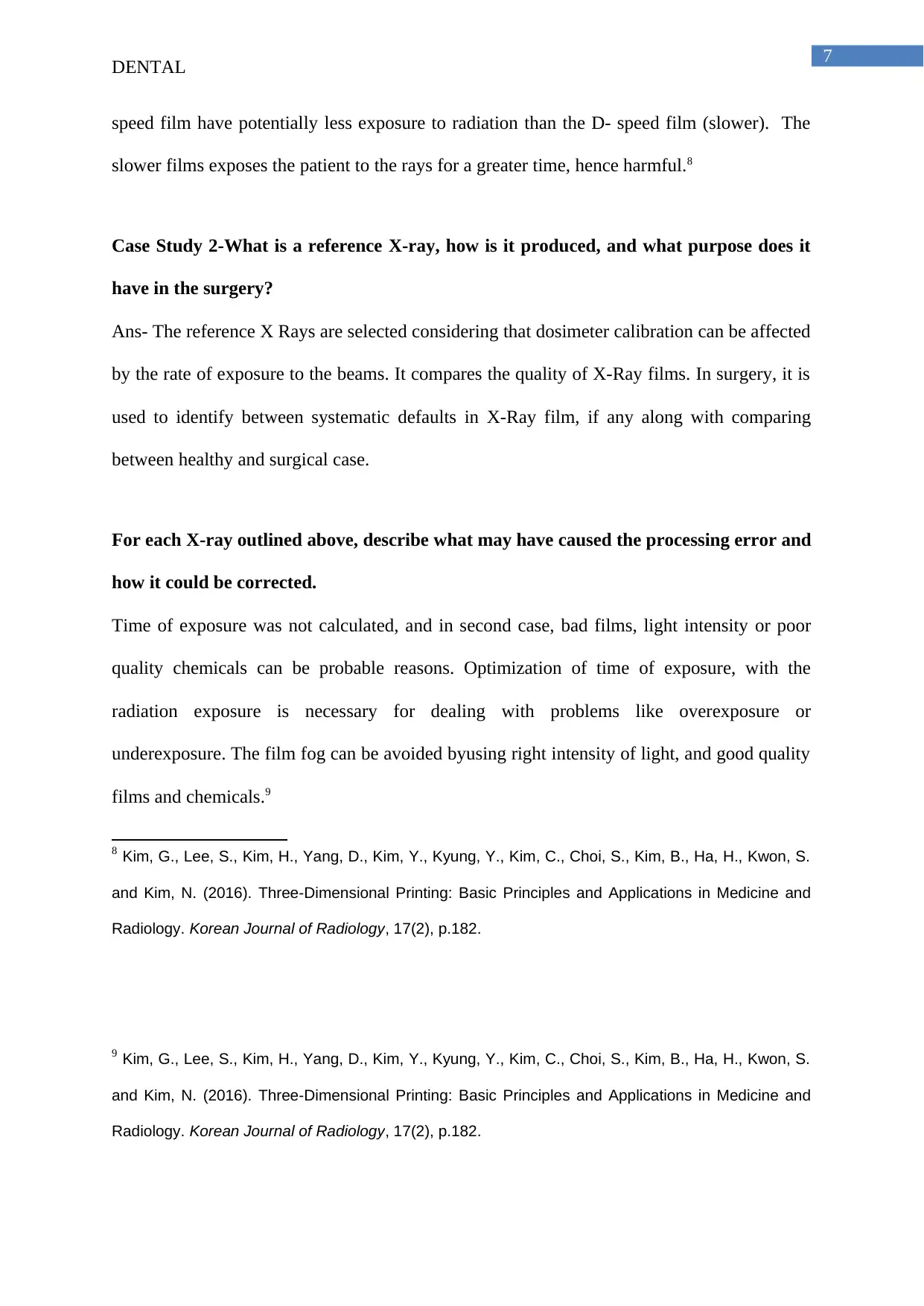
7
DENTAL
speed film have potentially less exposure to radiation than the D- speed film (slower). The
slower films exposes the patient to the rays for a greater time, hence harmful.8
Case Study 2-What is a reference X-ray, how is it produced, and what purpose does it
have in the surgery?
Ans- The reference X Rays are selected considering that dosimeter calibration can be affected
by the rate of exposure to the beams. It compares the quality of X-Ray films. In surgery, it is
used to identify between systematic defaults in X-Ray film, if any along with comparing
between healthy and surgical case.
For each X-ray outlined above, describe what may have caused the processing error and
how it could be corrected.
Time of exposure was not calculated, and in second case, bad films, light intensity or poor
quality chemicals can be probable reasons. Optimization of time of exposure, with the
radiation exposure is necessary for dealing with problems like overexposure or
underexposure. The film fog can be avoided byusing right intensity of light, and good quality
films and chemicals.9
8 Kim, G., Lee, S., Kim, H., Yang, D., Kim, Y., Kyung, Y., Kim, C., Choi, S., Kim, B., Ha, H., Kwon, S.
and Kim, N. (2016). Three-Dimensional Printing: Basic Principles and Applications in Medicine and
Radiology. Korean Journal of Radiology, 17(2), p.182.
9 Kim, G., Lee, S., Kim, H., Yang, D., Kim, Y., Kyung, Y., Kim, C., Choi, S., Kim, B., Ha, H., Kwon, S.
and Kim, N. (2016). Three-Dimensional Printing: Basic Principles and Applications in Medicine and
Radiology. Korean Journal of Radiology, 17(2), p.182.
DENTAL
speed film have potentially less exposure to radiation than the D- speed film (slower). The
slower films exposes the patient to the rays for a greater time, hence harmful.8
Case Study 2-What is a reference X-ray, how is it produced, and what purpose does it
have in the surgery?
Ans- The reference X Rays are selected considering that dosimeter calibration can be affected
by the rate of exposure to the beams. It compares the quality of X-Ray films. In surgery, it is
used to identify between systematic defaults in X-Ray film, if any along with comparing
between healthy and surgical case.
For each X-ray outlined above, describe what may have caused the processing error and
how it could be corrected.
Time of exposure was not calculated, and in second case, bad films, light intensity or poor
quality chemicals can be probable reasons. Optimization of time of exposure, with the
radiation exposure is necessary for dealing with problems like overexposure or
underexposure. The film fog can be avoided byusing right intensity of light, and good quality
films and chemicals.9
8 Kim, G., Lee, S., Kim, H., Yang, D., Kim, Y., Kyung, Y., Kim, C., Choi, S., Kim, B., Ha, H., Kwon, S.
and Kim, N. (2016). Three-Dimensional Printing: Basic Principles and Applications in Medicine and
Radiology. Korean Journal of Radiology, 17(2), p.182.
9 Kim, G., Lee, S., Kim, H., Yang, D., Kim, Y., Kyung, Y., Kim, C., Choi, S., Kim, B., Ha, H., Kwon, S.
and Kim, N. (2016). Three-Dimensional Printing: Basic Principles and Applications in Medicine and
Radiology. Korean Journal of Radiology, 17(2), p.182.

8
DENTAL
DENTAL
⊘ This is a preview!⊘
Do you want full access?
Subscribe today to unlock all pages.

Trusted by 1+ million students worldwide

i
1 out of 10
Related Documents
Your All-in-One AI-Powered Toolkit for Academic Success.
+13062052269
info@desklib.com
Available 24*7 on WhatsApp / Email
![[object Object]](/_next/static/media/star-bottom.7253800d.svg)
Unlock your academic potential
Copyright © 2020–2025 A2Z Services. All Rights Reserved. Developed and managed by ZUCOL.



